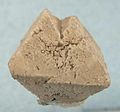| Revision as of 13:40, 24 December 2024 editJonesey95 (talk | contribs)Autopatrolled, Extended confirmed users, Page movers, Mass message senders, Template editors375,896 edits Fix Linter obsolete tag errors.← Previous edit | Revision as of 16:41, 24 December 2024 edit undoNamesnik (talk | contribs)Autopatrolled, Extended confirmed users663 editsm ochres galleryNext edit → | ||
| Line 18: | Line 18: | ||
| * Volgerite (obsolete) — a mineral form of antimony acid, identified in the mid-19th century by the German geologist ] as antimony ochre in the Algerian mines of ]. It is white or off-white in color.<ref name="Dana"/>{{rp|188}}, is now recognized as one of the varieties of ]. | * Volgerite (obsolete) — a mineral form of antimony acid, identified in the mid-19th century by the German geologist ] as antimony ochre in the Algerian mines of ]. It is white or off-white in color.<ref name="Dana"/>{{rp|188}}, is now recognized as one of the varieties of ]. | ||
| == |
== Antimony ochres gallery == | ||
| <br> | <br> | ||
| <gallery> | <gallery> | ||
Revision as of 16:41, 24 December 2024
Secondary minerals of antimony oxide class| Antimony ochre | |
|---|---|
 Cervantite (Guerrero, Mexico) Cervantite (Guerrero, Mexico) | |
| General | |
| Category | Mineral |
Antimony ochre (Antimony ocher in American English) or ochre of antimony (German: аntimonocker, French: antimon ochre) — a partially obsolete trivial name for secondary antimony minerals of the oxide class. Antimony ochres most often have the appearance of a powdery brown-yellow to whitish product of weathering (oxidation) of antimonite or native antimony. Usually they are not a pure mineral (one of the ochres), but a mixture of two or more minerals: cervantite, valentinite, romeite, senarmontite, stibiconite, sometimes with an admixture of limonite or quartz.
In the mineralogical sense of the word, antimony ochres are a loosely defined group of secondary antimony minerals of the oxide and hydroxide class. The most common antimony ochres are cervantite, romeite, and stibiconite, but their number is by no means exhaustive. At various times, this conditional list also included other names, some of which are now recognized as incorrect or non-existent.
Antimony ochres are associated ore minerals, often more difficult to obtain antimony than the main antimonite, in addition, they are found in nature in small quantities, as an impurity or coating, which is why they are rarely used separately. They received their name by analogy, for their external resemblance to light ochres.
Essential minerals
- Cervantite (German: Cervantit) or white lustrous antimony ore — antimony tetroxide with the ideal formula Sb2O4 or, in more detailed form, SbSbO4, an oxidation product of antimonite, along with valentinite — the lightest of the antimony ochers.
- Stibiconite (German: Stibiconit) or kumengite — a mineral of the oxide class of variable composition with the conventional formula (Sb,Ca)2-xSb2(O,OH)6-7•nH2O. The name stibiconite is very characteristic of all antimony ochres; from the Latin Stibium — antimony and the Greek χονίς (konis) — dust, powder.
- Romeite (German: Romeit) — a mineral of the oxide class from the stibiconite group with the theoretical formula (Ca,Na,Fe,Mn)2Sb2O6(O,OH,F). It is known in five varieties: atopite, schneeberghite, mauseliite, weslinite, lewisite.
- Valentinite (German: Valentinit) — one of the simplest oxidic antimony ochres, representing antimony oxide with the calculated formula Sb2O3. In antimony ochres it is usually found in a mixture with other antimony oxides.
- Senarmontite (German: Senarmontit) — a mineral of the same chemical composition as valentinite, less common, differing in syngony and forming rather large octahedral crystals, colorless, transparent, white or gray.
- Volgerite (obsolete) — a mineral form of antimony acid, identified in the mid-19th century by the German geologist Otto Volger as antimony ochre in the Algerian mines of Constantine Province. It is white or off-white in color., is now recognized as one of the varieties of stibiconite.
Antimony ochres gallery
See also
References
- ^ Krivovichev V. G. Mineralogical glossary. Scientific editor A. G. Bulakh. — St.Petersburg: St.Petersburg Univ. Publ. House. 2009. — 556 p. — ISBN 978-5-288-04863-0
- Robert Jameson. A System of Mineralogy. Vol.3: Class IV. Metallic Minerals. — Edinburgh, A. Constable & Co., 1816.
- Wang, Chung Yu. Antimony: its history, chemistry, mineralogy, geology, metallurgy, uses, preparations, analysis, production, and valuation; with complete bibliographies. — London, C. Griffin & company limited, 1909.
- ^ James Dwight Dana A. M., Brush G. J. A system of mineralogy : Descriptive mineralogy, comprising the most recent discoveries. — New York : J. Wiley & Sons, 1884.
- ^ Bulletin of the United States National Museum. Published under the Direction of the Smitsonian Institution. Washington: Governement Printing Office, No.32, 1887.
- A. A. Nemodruk. Analytical chemistry of antimony. — Moscow: V. I. Vernadsky Institute of Geochemistry and Analytical Chemistry, Nauka Publishing House, 1978. — 222 p.
- Chukhrov F. V., Bonshtedt-Kupletskaya E. M. Minerals. Handbook. Issue 3. Complex oxides, titanates, niobates, tantalates, antimonates, hydroxides. — Moscow: Nauka, 1967. — 676 p.
- P. M. Solozhenkin, Z. A. Zinchenko. Enrichment of antimony ores (ed. by V. A. Glembotsky). — Moscow: Nauka, 1985. — 180 p.
- V. N. Loginov, A. F. Bushmakin, V. I. Kainov and others. Oxides and hydroxides of antimony... Mineralogy of the Urals. Oxides and hydroxides. Part 2. — Ekaterinburg-Miass: Ural Branch of the Russian Academy of Sciences, 2007. — 288 p.
If an internal link incorrectly led you here, you may wish to change the link to point directly to the intended article. Categories:



